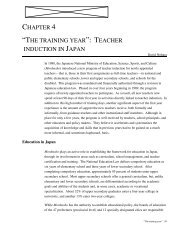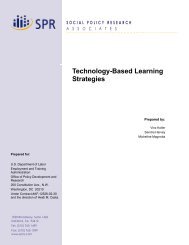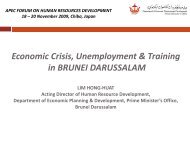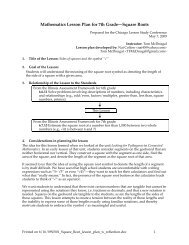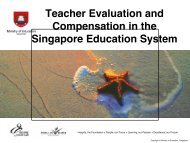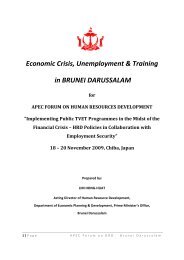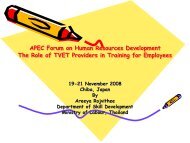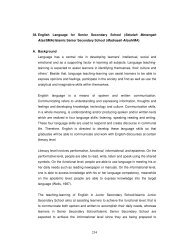Quality Assurance Systems in Asia-Pacific Economic Cooperation
Quality Assurance Systems in Asia-Pacific Economic Cooperation
Quality Assurance Systems in Asia-Pacific Economic Cooperation
You also want an ePaper? Increase the reach of your titles
YUMPU automatically turns print PDFs into web optimized ePapers that Google loves.
ENHANCEMENT OF QUALITY ASSURANCE SYSTEMS IN HIGHER EDUCATION IN APEC MEMBER ECONOMIES<br />
developed <strong>in</strong> the national context. For example, HKCAA considers non-university level HEIs<br />
as well as operators <strong>in</strong> the private sector and tra<strong>in</strong><strong>in</strong>g sector. S<strong>in</strong>ce the UGC of HK was<br />
already adequately pay<strong>in</strong>g attention to publicly funded universities of HK, what was needed <strong>in</strong><br />
the national context was a mechanism to look <strong>in</strong>to the areas where there were gaps and<br />
HKCAA pays attention to those areas. Thus the scope of HKCAA has been dictated by the<br />
national context and it is true for any other QA <strong>in</strong>itiative.<br />
AUQA is another example where the national context <strong>in</strong>fluences the scope of the agency.<br />
Australia is a federation of six States and two Territories. State and Territory Governments<br />
and the Australian Government have responsibility for manag<strong>in</strong>g cooperatively all higher<br />
education approval processes. The State and Territory Accredit<strong>in</strong>g Authorities carry out some<br />
approval processes <strong>in</strong> their respective jurisdictions and ensur<strong>in</strong>g national consistency <strong>in</strong> these<br />
processes is a key issue for Australia. Consequently, as the overarch<strong>in</strong>g body for quality<br />
assurance <strong>in</strong> the higher education sector, <strong>in</strong> addition to audit<strong>in</strong>g the Australian universities,<br />
AUQA audits the QA responsibilities of the State and Territory Accredit<strong>in</strong>g Authorities.<br />
<strong>Quality</strong> assurance mechanisms of the APEC region tend to consider both private and public<br />
players, aga<strong>in</strong> with a few exceptions <strong>in</strong>fluenced by the national context. For example, there<br />
are economies where the emergence of private sector <strong>in</strong>stitutions resulted <strong>in</strong> the need for an<br />
explicit quality assurance mechanism. While the m<strong>in</strong>istries had control (often fund<strong>in</strong>g-related)<br />
over the publicly funded <strong>in</strong>stitutions and programs, the need for a parallel mechanism to<br />
assure quality <strong>in</strong> the private sector that did not demand / have access to public funds resulted<br />
<strong>in</strong> the establishment of QA structures that paid attention only to the private sector. Malaysia,<br />
S<strong>in</strong>gapore and Hong Kong are typical examples. In S<strong>in</strong>gapore, SPRING covers the private<br />
<strong>in</strong>stitutions and it is only more recently that the M<strong>in</strong>istry of Education has <strong>in</strong>troduced an<br />
explicit QA system for the publicly funded universities and polytechnics. It should be noted<br />
that the trend is towards a convergence. This is likely <strong>in</strong> S<strong>in</strong>gapore, and Malaysia has already<br />
merged the two systems it had. The <strong>Quality</strong> <strong>Assurance</strong> Division of the m<strong>in</strong>istry for publicly<br />
funded HEIs and LAN for the private <strong>in</strong>stitutions have been merged <strong>in</strong>to the Malaysian<br />
Qualifications Authority (MQA) to cover both public and private HEIs.<br />
In general, the same standards are applied to both private and public HEIs. Some surveys<br />
mention that the standards are different. The difference may relate to the differential nature of<br />
the HEI or to the way QA developed <strong>in</strong> the economy. For example, <strong>in</strong> S<strong>in</strong>gapore the publicly<br />
funded <strong>in</strong>stitutions are expected to describe their performance <strong>in</strong> specified academic areas,<br />
no accreditation hangs on the result, and there are some government funds to assist with<br />
quality improvement after the review. The private providers, on the other hand have a<br />
compulsory quality assurance mechanism that protects foreign students’ fees, and an optional<br />
system that is based on a bus<strong>in</strong>ess excellence model.<br />
3.5 Aspects Considered for QA and Indicators of <strong>Quality</strong><br />
The areas and aspects considered for the quality assurance exercises are given <strong>in</strong> Appendix<br />
2. It should be noted that some cover QA at the <strong>in</strong>stitutional level and some mechanisms are<br />
at program level. Irrespective of the unit of quality assurance there are many overlapp<strong>in</strong>g<br />
areas. It is reasonable to assume that the difference is <strong>in</strong> the focus. When the <strong>in</strong>stitution is the<br />
focus of quality assurance, the standards or criteria would be about how well the <strong>in</strong>stitution is<br />
fulfill<strong>in</strong>g its responsibility as an educational <strong>in</strong>stitution, with some variations depend<strong>in</strong>g on the<br />
quality assurance framework. If the program is the unit of quality assurance, the educational<br />
provision and quality of the particular program and its graduates become the focus.<br />
Some QA systems have considered different emphases for different cycles of QA. For<br />
example, <strong>in</strong> New Zealand, NZUAAU has done three cycles of QA. For Cycle 1 (1995–1998), it<br />
considered all <strong>in</strong>stitutional aspects. For Cycle 2 (2000–2001) it gave an emphasis to research<br />
related aspects (policy and management, support for postgraduate research students, the<br />
research-teach<strong>in</strong>g nexus) and for Cycle 3 (2003–2006) the focus is teach<strong>in</strong>g related aspects<br />
(teach<strong>in</strong>g quality, programme delivery, the achievement of learn<strong>in</strong>g outcomes).<br />
Some more mature systems have an emphasis on quality audit and the “fitness-for-purpose”<br />
approach. They may <strong>in</strong>dicate only the scope of QA <strong>in</strong> broad areas such as Organisational<br />
12



